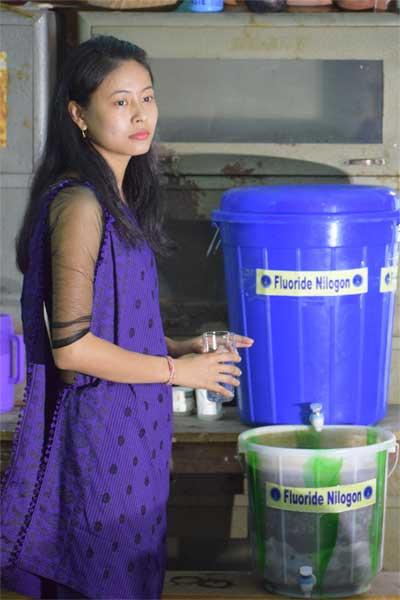Dengaon is a beautiful area consists green hills, plains and rivers in Brahmaputr a valley. More than 50 villages and most of its inhabitants are belong to Karbi tribe. This area in border of Nagoan and Karbi Anglong districts in Assam are highly and dangerously fluoride-affected in Brahmaputra valley.
The presence of excess amount of fluoride was tested in the water from rivers, ponds, wells, tube-well and deep-wells. Villagers have been suffering from fluoride for centuries which was detected in last decade. There are no drinking water supply facilities in remote villages which are not easily accessible. Symptoms of excess fluoride induced disorders are prevalent some states of the country including Brahmaputra valley. Karbi Anglong and Hojai districts are the most fluoride-affected districts in Assam.
Fluoride has been an invisible enemy contains in drinking water as chemical contaminant mostly in ground water in Brahmaputra valley. It has been a matter of grave concern that almost all districts in Assam are fluoride and arsenic affected. Villagers from different tribes and communities have been witnessing this demon with dental and skeletal flourosis. A small amount of fluoride is good for health but excess flouride of drinking water causes various health problems including damage of tooth and bone. Fluoride is a deadly poison. A long term ingestion of fluoride in drinking water and cooking water causes to other health problems. Affected villagers had no option to minimize the presence of fluoride and only some families use to drink filtered water. Moreover, general filter cannot remove or minimize fluoride.
Fortunately villagers have found a new low-cost technology to remove fluoride and iron from water recently. Now villagers are using this fluoride filter unit to have fluoride-free water. Villagers have installed Fluoride Nilogon - a low-cost and simple method for removal of fluoride from contaminated groundwater. Fluoride Nilogon is a method for removal of excess fluoride from contaminated groundwater for drinking purpose through phosphoric acid and crushed limestone treatment based on precipitation-absorption developed by a team of researchers led by Dr R K Dutta from Tezpur University, a central university in Assam. The name was coined from fluoride and Nilogon is an Assamese equivalent of 'removal' in English.
The method removes fluoride efficiently and selectively without leaving any toxic residual in the water at a recurring cost of ₹ 1 per 100 liter of water. The Fluoride Nilogon system can be custom designed to meet the requirements of the users ranging from small household to community. It uses a crushed limestone fixed-bed reactor where the water is treated for 3 hours in presence of a small quantity (0.00067 M) of phosphoric acid.

Bhabesh Bhagwati, a local social worker who is in charge of the unit installed near Dengaon Higher Secondary School said, " For small communities like school a 200 or 500 litre plastic drum can be used as the reactor and another 200 litre drum can be used as the sand gravel filter. After filling with crushed limestone, a 200 liter drum can be hold about 88 litre and a 500 litre drum can hold about 220 litre of water. The filter shuld have a 15-20 cm layer of small 2-3 cm size gravels, at the bottom, covered by a thin porous cloth, above which, there should be a 50-60 cm thick layer of clean medium size sand. People have been collecting water from a community unit set up near Dengaon Higher Secondary School for a year which was set up experimentally first.
After long sufferings and government negligence people of some villages of Dengaon region in Karbi Anglong districts have choosed to use "Fluoride Nilogon" unit to get fluoride-free water. "In Fluoride Nilogon, the flouride containing water, mixed with a small quantity of phosphoric acid, is put into a crushed limestone bed plug-flow reactor and kept for a residence time of at least three hour. Fluoride is removed in the reactor. The water is filtered using a sand-gravel filter after three hours" - Dr R K Dutta said.
The Flouride Nilogon method has been developed by a group of researchers lead by Dr. R K Dutta in the Department of Chemical Sciences, Tezpur University. Flouride Nilogon removes the excess fluoride retaining only a small amount of fluoride (0.7 ppm) require for a good health. The treatment water does not contain any residual chemical added from outside. Its pH is about 7.5 which is very safe for drinking. However, the treated water should be consumed only after booiling.
Families can use a Fluoride Nilogon unit with arrangement of minimum two big size buckets as water from upper bucket can come to lower bucket using a tap. It must be sure that the tap of the upper 40 liter bucket which contain crushed limestone container is closed. 15 liter of water is added in the bucket. Then 7 ml of the dilute phosphoric acid solution be added to it and mix. Then the amount of acid solution mixed water poured in the first bucket containing crushed limestone and let it for at least three hours. In a 30 liter crushed limestone bucket, 11 liter water can be treated and and 55.2 ml phosphoric acid has to be added. There is no harm if you leave it like that for longer time even for a day. Fluoride is removed here along with neutralization of the acid. Now water can be filtered using the sand gravel filter in second lower bucket.
A household unit used by common people consists of a plastic bucket of 40 litre capacity for the reactor and another 20 litre bucket for the sand-gravel filter. Both buckets are fitted with a plastic tap each towards the bottom. The 40 litre treatment bucket is kept at a level above the filter. The 40 litre bucket is filled with crushed limestone of 0.1 to 1.5 cm size. This limestone-filled bucket can hold about 15 litre of water. The filter should have an 8-10 cm thick layer of small 2-3 cm size gravel layer at the bottom. The rest of the bucket should be thin porous cloth between the sand and the gravel layer to stop sand from going to the gravel layer.
Families from Dengaon area acknowledged benefits of Fluoride Nilogon to get fluoride-free water. Some people are using water from community set up and some have installed their own set up inside their house. The solution used in the method is a dilute solution (8.5%) of an acid even though it is a weak acid, it shoul be kept carefully. It should be kept away from children. with water in case of its contact with hand, skin or eye.
It is a simple efficient and low-cost method of removing excess fluoride from water. It this method crushed limestone is used along with a very small amount of a solution of a weak acid called phosphoric acid. The use of phosphoric acid in water purification is safe. Phosphoric acid is used in packaged food and soft drinks like Pepsi.







Add new comment